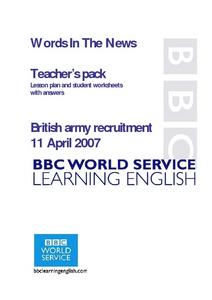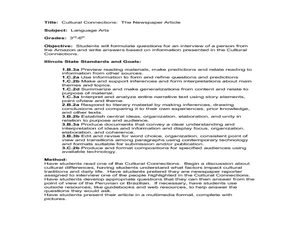Curated OER
Fact vs. Opinion (Part II)
How can you tell the difference between fact and opinion? Using newspapers, learners determine which articles contain statements of fact, and which articles reflect the writer's opinion. The lesson plan includes a discussion format and a...
Benjamin Franklin Tercentenary
Reading the Work of B. Franklin, Printer
Placing Ben Franklin’s ideas about a free press next to those embodied in the First Amendment sheds light on both. Learners interpret and compare two primary sources and then examine them in the light of a contemporary survey about...
Benjamin Franklin Tercentenary
From Ben’s Pen to Our Lives
What would Ben do? Jumping off from the pseudonymous letters Ben Franklin fooled his older brother into publishing when he was still a teenager, young literary lovers dive into acting, writing, and addressing a local issue with wit and...
Curated OER
Academic Achievement
Academic goals can lead high schoolers toward bright futures. Get your class to think about where they want to be in 20 years and what they'll need to do to get there with this lesson plan. Learners fill out a brief questionnaire about...
Curated OER
Crocodiles Escape in Vietnam
What, there was a crocodile escape? Read, analyze, and examine a newspaper article with your class about the crocodiles that escaped in Vietnam. Your English language learners note the facts and key vocabulary in the story and answer...
Curated OER
British Army Recruitment
Read and discuss the vocabulary related to a news article about a new recruitment campaign for the British army. High schoolers read the article, define key vocabulary terms, identify suffixes from the article, and complete a variety of...
Curated OER
The Newspaper Article
Have your class participate in an interview activity using an informational text about the Amazon. After reading a Cultural Connections story about a person from the Amazon, middle schoolers write interview questions based on the text....
Curated OER
The Final Word
Although this instructional activity is based on “Final Word,” Craig Wilson’s USA Today column, the strategies could be adapted to any local columnist. After reading three articles independently, groups share observations about content...
Curated OER
Lesson: Extra! Extra! Read All About It!
A great idea for a fun homework assignment! The class fully and critically analyzes Daniel Sprick's painting, Your Plans. They then generate questions to ask the artist as they attend a mock press conference. They pretend to ask the...
Curated OER
Aztec Myths: Writing Editorials
Middle schoolers write an editorial giving an opinion of whether or not Quetzalcoatl has arrived and if so, what the Aztecs should do. They discuss whether or not they believe Quetzalcoatl is a god or a man, and use an Editorial...
Curated OER
Iran Hostage Crisis: Reading Primary Documents
Following brief instruction about the Iran Hostage Crisis during Jimmy Carter's presidency, small groups read three-page sections from the diary of hostage Robert C. Ode. They write editorials from the perspective of either U.S. citizens...
Curated OER
School for Santas
Being able to read and recall is a very important skill. Why not have learners read about an American holiday phenomenon? They'll answer who, what, when, where, why, and how with regard to a New York Times article about a school for...
Curated OER
Fun, and Risks, at the Beach in Tel Aviv
After reading the article "Fun, and Risks, at the Beach in Tel Aviv," learners consider eight related questions. They'll answer who, what, when, where, why, and how about the risks several Palestinian women took as they snuck over the...
Curated OER
Racial Tensions for Mixed Families
"Racial Tensions for Mixed Families" is the title of the New York Times article your class gets to read, if they click on this resource. They'll read the article then answer 10 comprehension questions.
Curated OER
Study: Largest Wealth Disparities in 25 Years
The New York Times has produced an article specifically geared to its younger readers. They read an article entitled, "Largest Wealth Disparities in 25 Years" to answer six comprehension questions. They'll be asked who, what, where,...
Curated OER
The U.S. War in Iraq Officially Ends
Examine issues and events surrounding US withdrawal of troops from the Iraq War. After reading this New York Times article learners respond to each of the nine who, what, when, where, and why questions.
Curated OER
The Coachella Festival
A New York Time article on a major music and arts event can be a good way to get kids interested in the daily news. They read an article about Coachella, and then answer eight comprehension questions, in either blog or print form. Note:...
Curated OER
Earthquake Strikes Virginia
In August of 2011 an earthquake shook the nation's capitol, and became a newsworthy event; learners read this New York Times article to find out why. They read the piece then answer nine related comprehension questions. Two additional...
Curated OER
Disposables and Deforestation
Ever think about the impact those cool disposable chopsticks have on the environment? Read about a group of students in Beijing who created a forest using nothing but tossed out chopsticks. Find out how this artistic endeavor is making a...
Curated OER
Preparing for Passover
Informational texts come in all shapes and sizes. Your kids will read the New York Times article, "Preparing for Passover" then answer seven comprehension questions. The answer to each question is located in embedded hyperlinks.
Curated OER
In Legal Limbo
Newspapers are great learning tools. They act as a conduit for current events, reading comprehension, and critical thinking. Here, pupils read a New York Times article regarding US immigration law under the Obama administration and...
Curated OER
Cute, Colored and Contentious
Whether your class responds to the blog linked to this article, or just answers the nine related questions, they're in for an eye-opening read. Pupils consider animal rights as they read a New York Times article about two men who have...
Curated OER
The World's Newest Nation
Reading comprehension can be fostered in many ways. Learners become informed as the read a New York Times article on the South Sudan, the world's newest nation. They read the article and then answer each of the 12 related questions.
Curated OER
Pass This Jobs Bill
It seems that print media is slowly being replaced by electronic versions. Get your kids reading the New York Times e-style. They'll read the provided article entitled, "Pass This Jobs Bill" then answer six comprehension questions. Two...
Other popular searches
- Broadcast Journalism
- Yellow Journalism
- Journalism School Newspapers
- Journalism Layout
- Journalism Lesson Plans
- Investigative Journalism
- Photo Journalism
- Broadcast
- Journalism Introduction
- Journalism History
- Radio Broadcast
- Journalism and the Media

























